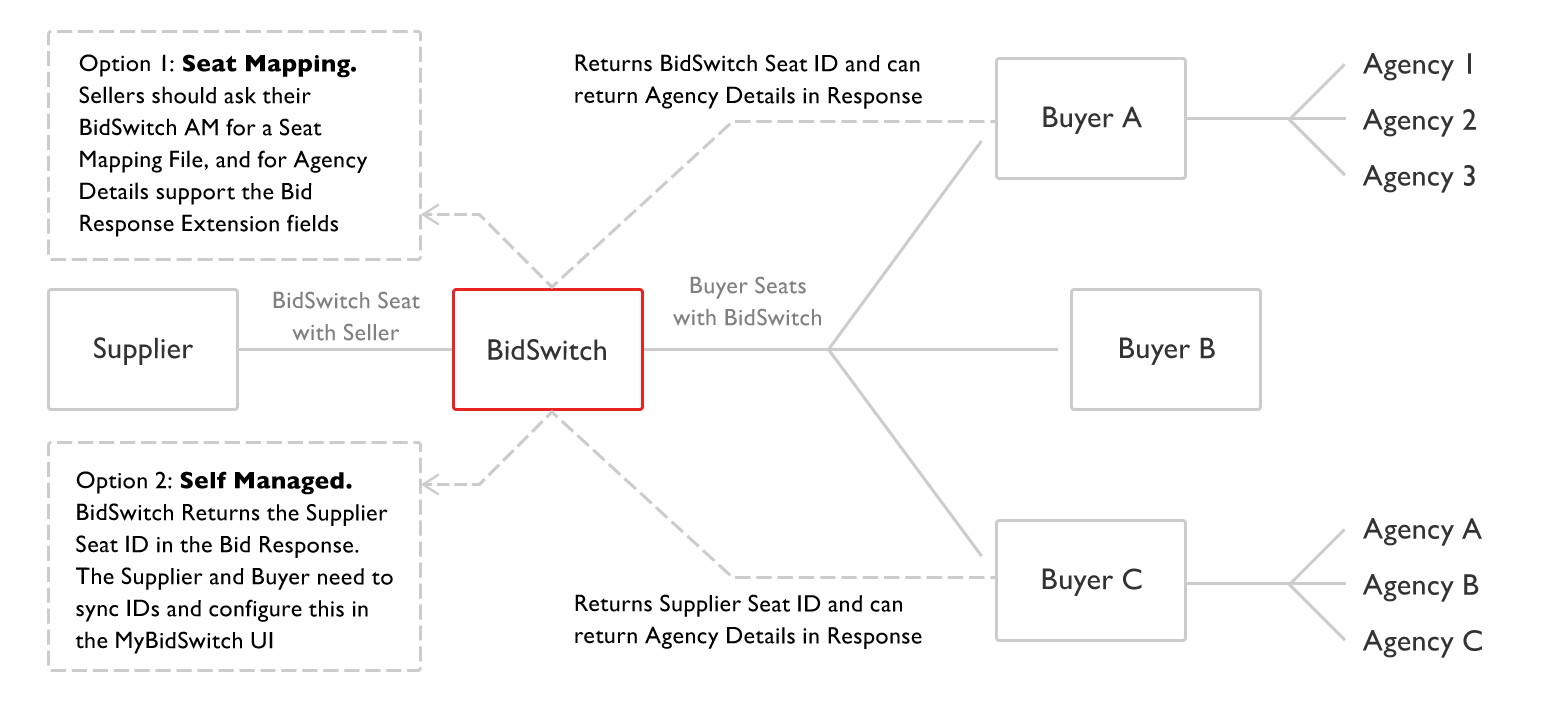Seat ID and Agency Mapping¶
Buyers and Suppliers assign seats to each party connected to their system. When trading through BidSwitch though, there is an additional layer of Seat IDs to take into account. The following overview outlines why this arises.
All Suppliers assign one or more Seat ID(s) to their connected Buyers.
All Buyers connected to BidSwitch have a BidSwitch Seat ID.
The BidSwitch seat at each Supplier acts as a proxy to all Buyers on BidSwitch.
For Buyers and Suppliers to identify each other through BidSwitch they need to get the BidSwitch Seat List (Seat Mapping), or configure BidSwitch to use their own Seat IDs (Seat Self-Management).
Seat Mapping lets Suppliers map their Buyer Seat IDs to those used in BidSwitch, see the Seat Mapping section.
Seat Self-Management lets Buyers and Suppliers use their own seat numbers with each other through BidSwitch. This means that both parties must ensure that they communicate with one another to use the correct seat numbers in Bid Requests/Responses and configure this in the myBidSwitch UI. See the Seat Self-Management section.
For Buyers, there is also a Single Seat Response feature, where the Buyers can have their account set up so that they respond with the same Seat ID for all requests. In this scenario responding to Bid Requests with the Seat ID value is optional because BidSwitch knows what it should be. BidSwitch will pass the expected seat value to the Supplier.
Trading Partner Identification Options

Seat Mapping¶
Seat Mapping means that the Supplier gets the BidSwitch Seat ID list and uses that to identify the Buyer from the Bid Response. This is usually used when trading in Media Mode.
When Buyers respond to a bid request, they include their seat number in the response.
To get a list of Buyers, Suppliers should contact their BidSwitch Account Manager. The Seat ID can be found and processed from the Seat Bid Object object.
{
"seatbid":[
{
"bid":[
{
"id":"1"
}
],
"seat":"8"
}
]
}
Seat Self-Management¶
To configure a Buyer with a Supplier generated ID, the Buyer and Supplier need to coordinate this using the following steps.
The Supplier needs to create an ID for that Buyer in their system.
The Supplier needs to inform the Buyer about their ID.
The Buyer needs to contact support@bidswitch.com to set up the Supply Partner ID in the myBidSwitch UI. Once configured, both parties trade with one another using this ID.
{
"seatbid":[
{
"bid":[
{
"id":"1"
}
],
"seat":"supplierID_1234"
}
]
}
Note
Buyers respond to BidSwitch with their Supplier seat ID.
There’s a number of benefits to setting up your account in this manner, firstly is allows for clearer reporting as knowing the Seat IDs allows Suppliers to have greater reporting clarity, right down to the the Buyer level, and lets them understand where their BidSwitch revenue comes from.
Secondly, with more visibility and a deeper understanding of Buyer activity, Suppliers can gain the same control over their BidSwitch Buying partners as they have with directly integrated Buyers (i.e. ability to block, prioritize, etc.)
Finally, it helps to build direct-like partnerships by letting you understand what kinds of inventory certain Buyers tend to be more focused on. As a result Suppliers can work directly with Buyers and potentially increasing revenue and leverage seat mapping for direct deals to Buyers, see the Private Marketplaces & Deal IDs section for details. The following Suppliers have set up their integration with BidSwitch to expect their IDs used in the following trading modes.
Media Mode |
Connect Mode |
|---|---|
AppNexus |
Reklamstore |
Stroeer SSP |
Google AdX |
Rubicon |
Rubicon |
Verizon Media Exchange |
Verizon Media Exchange |
YieldLab |
YieldLab |
YieldOne |
YieldOne |
MicroAd |
MicroAd |
BroadSign |
|
BounceX |
|
Freewheel |
|
Kargo |
|
I-Mobile |
|
TrustX |
|
Taboola |
|
Outbrain |
|
The Media Grid |
Agency Mapping¶
Suppliers can identify the agencies that a Buyer represents from information contained in the bid response, if the Supplier supports the following bid response extension fields.
If you support these fields, then you should contact your connected Buyers on BidSwitch to request they include this information in their bid responses. See the Bid Ext Object section, for more details. Additionally some Suppliers require these fields in a bid response, see the Required Bid Response Fields Per Supplier section.
seatbid.bid.ext.advertiser_nameseatbid.bid.ext.agency_nameseatbid.bid.ext.agency_id
{
"ext":{
"advertiser_name":"Coca-Cola",
"agency_id":"123",
"language":"en",
"agency_name":"CC-advertising"
}
}
There’s a number of benefits form setting this up, as it lets Suppliers understand how their BidSwitch revenue is is broken down by Agency. It also gives you greater Buyer understanding by knowing which agencies buy particular kinds of inventory. This helps to inform Suppliers and ultimately leads to better decisions being made which can lead to more mutually beneficial Supplier - Buyer relationships.
